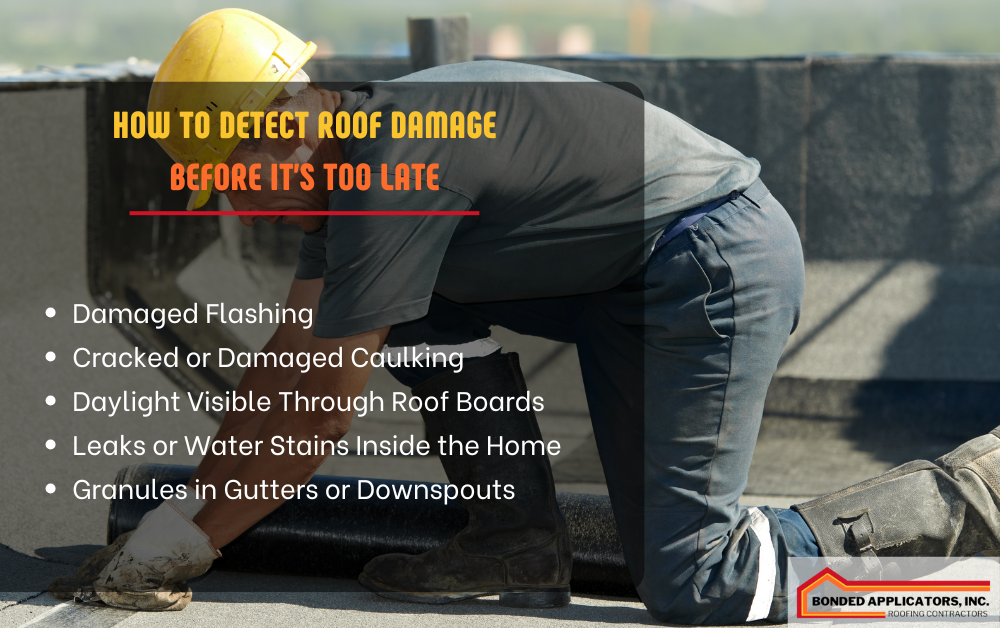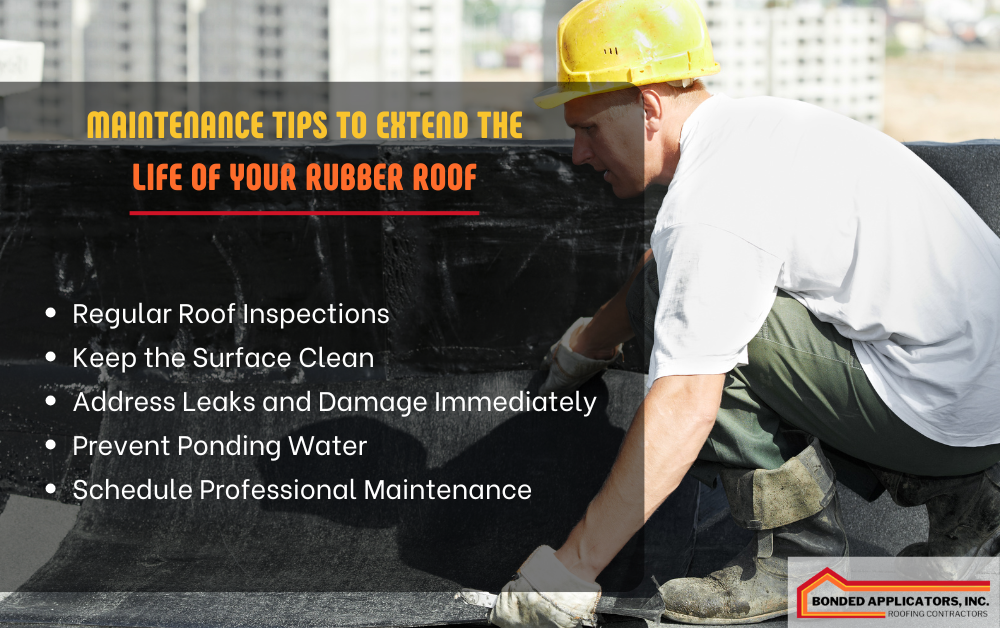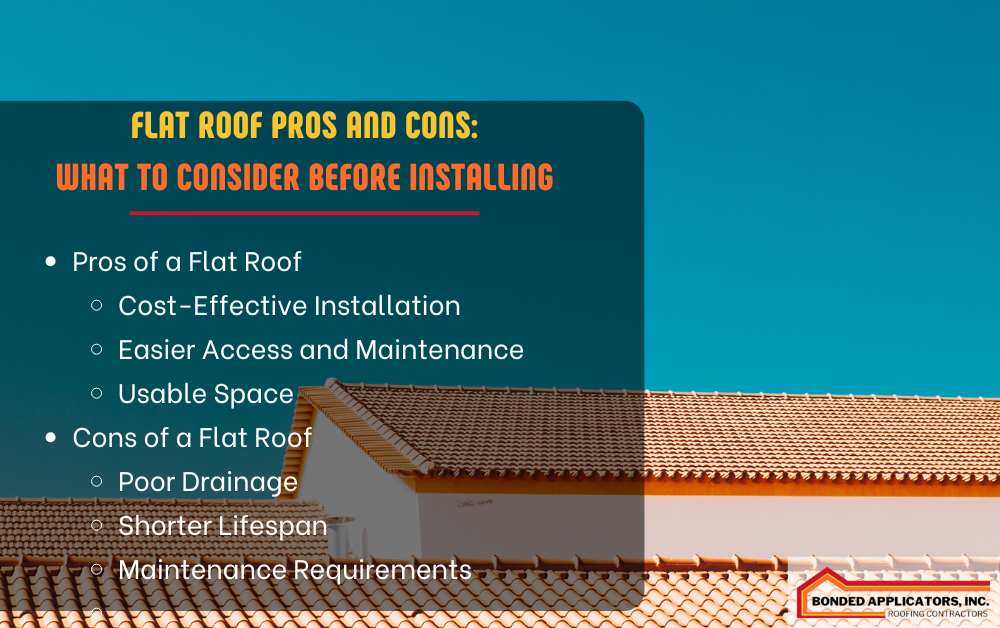When it comes to protecting your home, your roof plays a critical role in keeping you safe from the elements. However, over time, exposure to weather, aging materials, and everyday exposure can gradually damage your roof, causing damage that may not be immediately obvious. If left unattended, minor issues can quickly develop into costly repairs or even structural problems that threaten the safety of your home. At Bonded Applicators, we understand how important it is to catch roof damage early before it becomes a major headache. That’s why knowing the signs to watch for protects both the financial and physical stability of your home.
Damaged Flashing: A Hidden Risk
What is Flashing?
Flashing consists of slender metal strips placed around sections that cut through the roofing material, such as vents, skylights, and chimneys. Its primary purpose is to seal joints and prevent water from entering the roof system at these vulnerable points. When functioning correctly, flashing acts as a water barrier, directing moisture away from critical areas and keeping your roof dry. Without intact flashing, your roof’s waterproof integrity is severely compromised. This can lead to leaks and interior deterioration caused by water, potentially leading to significant expenses.
Signs of Flashing Damage
Damaged flashing can appear broken, bent, or loose and is often difficult to detect without a close inspection. If flashing becomes corroded or displaced, water can seep underneath, causing leaks and rot in the underlying roof structure. Homeowners might notice water stains or dampness around chimneys, vents, or skylights, signaling flashing problems. Because flashing is usually hidden from view, damage can go unnoticed until significant harm occurs.
Why Timely Repair Matters
Fixing damaged flashing as soon as it’s identified is crucial to preventing water intrusion and structural decay. Professionals can reseal or replace flashing to restore its protective function and prevent leaks. Delaying repairs often results in more costly fixes, including damage to insulation, ceilings, or even the framing of your home. Proper flashing maintenance is a key step to preserving your roof’s longevity and protecting your property investment. Ignoring flashing issues can lead to a cascade of expensive problems.
Cracked or Damaged Caulking: Small Gaps, Big Problems
The Role of Caulking on Roofs
Caulking is the flexible sealant used to fill gaps around roof penetrations like vents, pipes, and chimneys. It creates a watertight barrier where flashing and roofing materials meet, preventing moisture from seeping into your home. Properly applied caulking adapts to temperature changes without cracking, maintaining a strong seal throughout the seasons. This seal is essential in protecting your home’s interior from water damage. Neglecting caulking can result in serious issues down the road.
Causes and Signs of Caulking Failure
Over time, sun exposure, weather, and temperature shifts cause caulking to crack, shrink, or peel away from the surfaces it’s meant to protect. This degradation leads to small but critical gaps that allow water to enter beneath roofing layers. Visible cracking, missing sealant, or peeling caulk around roof fixtures is a clear sign that maintenance is needed. Disregarding these problems increases the risk of leaks, mold growth, and structural damage. Homeowners should regularly inspect caulking, especially after harsh weather.
Maintaining Caulking for Roof Health
Routine inspection and resealing of caulking prevent leaks and extend your roof’s lifespan. Professional roofers have the right tools and materials to apply durable sealant in vulnerable spots, ensuring a long-lasting fix. Regular upkeep keeps your roof watertight and reduces the chance of costly repairs later on. Early caulking maintenance is a simple, effective way to protect your home and save money. Scheduling professional inspections annually can catch these problems before they escalate.
Daylight Visible Through Roof Boards: A Clear Warning Sign
What Does Visible Daylight Mean?
If rays of sunlight are passing through cracks or holes in the roof from inside your attic or home, it indicates holes or gaps in the roofing structure. This means the roof is no longer a complete barrier against weather, pests, and environmental hazards. Such openings compromise your home’s protection and energy efficiency, allowing cold air, moisture, and insects inside. It also signals serious structural issues that require immediate attention. Ignoring visible daylight can lead to bigger problems very quickly.
Risks of Unsealed Gaps
Openings that let light through also allow rain, unwanted exposure to snow and wind indoors, which can result in water damage to insulation, ceilings, and walls. Moisture intrusion can weaken your home’s structural elements and cause mold growth, impacting indoor air quality. Openings in the roof can serve as easy access points for pests like insects and rodents to make their way into your home through these gaps, causing further damage. These issues contribute to higher energy bills due to loss of insulation efficiency. Addressing these gaps early is essential to maintaining a safe and healthy home environment.
Taking Immediate Action
Visible daylight should never be ignored and requires prompt professional assessment. An expert roofer can find the root of the damage and suggest effective remedies to restore the roof’s integrity. Quick action prevents further damage and helps maintain a safe, dry living environment. Scheduled roof evaluations allow for early detection of damage, especially post-storm or high wind exposure. Timely repairs ensure your home remains secure and energy-efficient.
Leaks or Water Stains Inside the Home: Signs You Shouldn’t Ignore
Identifying Indoor Water Damage
Water damage typically suggests roofing issues. These stains usually indicate moisture has penetrated your roofing system and is damaging your home’s interior surfaces. Sometimes the smell of mold or mildew accompanies these visual signs, which can be harmful to your family’s health.
Why Indoor Leaks are Serious
Water leaks can damage drywall, insulation, and structural elements, weakening your home over time. Extended periods of moisture can promote mold accumulation, which presents considerable health dangers, notably for individuals with asthma or allergy concerns.. Leaks can also damage electrical wiring, creating a potential fire hazard. Ignoring leaks often results in more expensive repairs and decreased property value. Repairing leaks promptly protects both your home and your loved ones.
How to Respond to Water Damage
If you detect water spots or leaks inside your home, schedule a roof inspection immediately. A professional roofer can trace the leak’s origin and recommend the necessary repairs before further damage occurs. Timely fixes preserve your home’s structure and keep your family safe and comfortable. Regular roof maintenance also helps prevent leaks from developing in the first place. Don’t delay—addressing leaks quickly is key to long-term roof health.
Granules in Gutters or Downspouts: An Early Indicator of Shingle Wear
What Are Shingle Granules?
Asphalt shingles are covered with tiny granules that shield the roofing material from UV rays and weather damage. Over time, these granules wear off naturally and accumulate in gutters or downspouts. While some loss is normal with aging, excessive granule shedding can indicate that your shingles are deteriorating prematurely. This loss reduces the shingles’ ability to protect your roof effectively. Monitoring granule loss is an integral part of roof maintenance.
Why Granule Loss Is a Concern
When shingles lose too many granules, their protective ability diminishes, making them more susceptible to cracking, curling, and leaks. Excessive granule loss often signals that your roof is approaching the end of its useful lifespan. Homeowners may notice bald spots on shingles or find a large amount of granules collecting in gutters. If left unchecked, this can lead to more severe roof damage requiring replacement. Timely attention to granule loss helps avoid sudden roofing failures.
Monitoring and Repairing Granule Loss
Regularly checking your gutters for granules helps you track your roof’s condition and aging process. If you detect significant granule buildup, it’s time to call a roofing professional for evaluation. A qualified roofer can assess whether repair or replacement is necessary to protect your home. Early intervention prolongs roof life and avoids costly emergency repairs. Scheduled inspections are a smart way to stay ahead of these issues.
Conclusion
Comprehending the early markers of roof damage is necessary for maintaining your home’s safety, comfort, and value. Damaged flashing, cracked caulking, visible daylight, indoor water stains, and granules in gutters all signal that your roof may need professional attention. Bonded Applicators is committed to helping homeowners detect and repair roof damage promptly to prevent costly issues down the line. Protect your investment and avoid major repairs by scheduling a professional roof inspection today. Contact Bonded Applicators to keep your roof in excellent shape throughout the seasons, ensuring your home is well defended.



